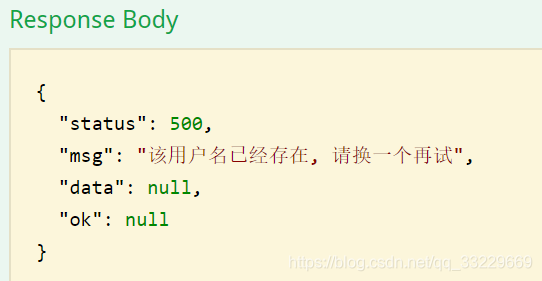- 一.引入依赖
- 二.编写Swagger2的配置类
- 三.Swagger2在Controller中的使用
- 四.Swagger2在model中的使用
- 五.在启动类中完善注解
- 六. 启动项目进行测试
在 thc-videos-dev-common 模块中,引入swagger2的依赖
io.springfox
springfox-swagger2
2.4.0
io.springfox
springfox-swagger-ui
2.4.0
在thc-videos-dev-mini-api 模块中, 编写swagger2的配置类 在此配置类中,主要配置Controller的扫描包路径, 以及接口文档的作者联系信息等
package com.thc;
import org.springframework.context.annotation.Bean;
import org.springframework.context.annotation.Configuration;
import springfox.documentation.builders.ApiInfoBuilder;
import springfox.documentation.builders.PathSelectors;
import springfox.documentation.builders.RequestHandlerSelectors;
import springfox.documentation.service.ApiInfo;
import springfox.documentation.service.Contact;
import springfox.documentation.spi.DocumentationType;
import springfox.documentation.spring.web.plugins.Docket;
import springfox.documentation.swagger2.annotations.EnableSwagger2;
/**
* 类名称:Swagger2
* 类描述:swagger2的配置类
*
* @author: taohongchao
* 创建时间:2019/6/2 14:42
* Version 1.0
*/
@Configuration
@EnableSwagger2
public class Swagger2 {
/**
* 方法名: createRestApi
* 方法描述: swagger的扫描Controller包配置
* 修改日期: 2019/6/2 14:46
* @param
* @return springfox.documentation.spring.web.plugins.Docket
* @author taohongchao
* @throws
*/
@Bean
public Docket createRestApi(){
return new Docket(DocumentationType.SWAGGER_2).apiInfo(apiInfo()).select()
.apis(RequestHandlerSelectors.basePackage("com.thc.controller"))
.paths(PathSelectors.any()).build();
}
/**
* 方法名: apiInfo
* 方法描述: 编写接口文档的相关信息
* 修改日期: 2019/6/2 14:50
* @param
* @return springfox.documentation.service.ApiInfo
* @author taohongchao
* @throws
*/
private ApiInfo apiInfo(){
return new ApiInfoBuilder()
//页面的标题
.title("微信小程序短视频接口文档")
//联系人
.contact(new Contact("java持续实践", "https://blog.csdn.net/qq_33229669", "xxx@163.com"))
//接口文档的描述
.description("欢迎访问短视频接口文档")
//定义版本号
.version("1.0").build();
}
}
修改上一节中,用户注册的Controller, 使其增加Swagger的相关信息
在Controller类的上方,增加了如下的注解, tags用于在接口页面中显示说明此Controller的作用. @Api(value = "用户注册登录的接口",tags = {"注册和登录的Controller"}) 实际显示的效果如下图  在接口的方法上增加如下的注解, 其中notes用于显示说明该接口的用途
在接口的方法上增加如下的注解, 其中notes用于显示说明该接口的用途 @ApiOperation(value = "用户注册",notes = "用户注册的接口") 显示的效果如图 
package com.thc.controller;
import com.thc.pojo.Users;
import com.thc.service.UserService;
import com.thc.utils.JSONResult;
import com.thc.utils.MD5Utils;
import io.swagger.annotations.Api;
import io.swagger.annotations.ApiOperation;
import org.apache.commons.lang3.StringUtils;
import org.springframework.beans.factory.annotation.Autowired;
import org.springframework.web.bind.annotation.PostMapping;
import org.springframework.web.bind.annotation.RequestBody;
import org.springframework.web.bind.annotation.ResponseBody;
import org.springframework.web.bind.annotation.RestController;
/**
* 类名称:RegistLoginController
* 类描述:用户注册的Controller
*
* @author: taohongchao
* 创建时间:2019/6/2 11:35
* Version 1.0
*/
@RestController
@Api(value = "用户注册登录的接口",tags = {"注册和登录的Controller"})
public class RegistLoginController {
@Autowired
private UserService userService;
/**
* 方法名: regist
* 方法描述: 用户注册的方法
* 修改日期: 2019/6/2 11:37
* @param user
* @return com.thc.utils.JSONResult
* @author taohongchao
* @throws
*/
@ApiOperation(value = "用户注册",notes = "用户注册的接口")
@PostMapping("/regist")
public JSONResult regist(@RequestBody Users user) throws Exception {
//1. 判断用户名和密码必须不为空
if (StringUtils.isBlank(user.getUsername()) || StringUtils.isBlank(user.getPassword())) {
return JSONResult.errorMsg("用户名和密码不能为空");
}
//2. 判断用户名是否存在
boolean usernameIsExist = userService.queryUsernameIsExist(user.getUsername());
//3. 保存用户, 注册信息
if (usernameIsExist) {
//用户名存在 , 提示错误信息给用户
return JSONResult.errorMsg("该用户名已经存在, 请换一个再试");
} else {
//用户名信息不存在, 保存注册信息
user.setNickname(user.getUsername());
// 把用户密码进行md5 加密
user.setPassword(MD5Utils.getMD5Str(user.getPassword()));
//初始化参数信息
user.setFansCounts(0);
user.setReceiveLikeCounts(0);
user.setFollowCounts(0);
userService.saveUser(user);
}
return JSONResult.ok();
}
}
在model中使用Swagger2的注解,用于规定哪些参数是必须传递的. 在model类上使用如下的注解,用于说明该model的用途. @ApiModel(value = "用户对象",description = "这是用户对象")  在用户名和密码的属性上,加上了如下的注解,用于给出该属性的中文名称, 传递参数的示例,其中
在用户名和密码的属性上,加上了如下的注解,用于给出该属性的中文名称, 传递参数的示例,其中required = true代表该参数是必填的. @ApiModelProperty(value = "用户名",name = "username",example = "username",required = true)
package com.thc.pojo;
import io.swagger.annotations.ApiModel;
import io.swagger.annotations.ApiModelProperty;
import javax.persistence.*;
@ApiModel(value = "用户对象",description = "这是用户对象")
public class Users {
@Id
// hidden为true代表为在接口文档中 不显示此属性
@ApiModelProperty(hidden = true)
private String id;
/**
* 用户名 required = true 代表为必填项
*/
@ApiModelProperty(value = "用户名",name = "username",example = "username",required = true)
private String username;
/**
* 密码
*/
@ApiModelProperty(value = "密码",name = "password",example = "password",required = true)
private String password;
/**
* 我的头像,如果没有默认给一张
*/
@Column(name = "face_image")
@ApiModelProperty(hidden = true)
private String faceImage;
/**
* 昵称
*/
private String nickname;
/**
* 我的粉丝数量
*/
@Column(name = "fans_counts")
@ApiModelProperty(hidden = true)
private Integer fansCounts;
/**
* 我关注的人总数
*/
@Column(name = "follow_counts")
@ApiModelProperty(hidden = true)
private Integer followCounts;
/**
* 我接受到的赞美/收藏 的数量
*/
@Column(name = "receive_like_counts")
@ApiModelProperty(hidden = true)
private Integer receiveLikeCounts;
/**
* @return id
*/
public String getId() {
return id;
}
/**
* @param id
*/
public void setId(String id) {
this.id = id;
}
/**
* 获取用户名
*
* @return username - 用户名
*/
public String getUsername() {
return username;
}
/**
* 设置用户名
*
* @param username 用户名
*/
public void setUsername(String username) {
this.username = username;
}
/**
* 获取密码
*
* @return password - 密码
*/
public String getPassword() {
return password;
}
/**
* 设置密码
*
* @param password 密码
*/
public void setPassword(String password) {
this.password = password;
}
/**
* 获取我的头像,如果没有默认给一张
*
* @return face_image - 我的头像,如果没有默认给一张
*/
public String getFaceImage() {
return faceImage;
}
/**
* 设置我的头像,如果没有默认给一张
*
* @param faceImage 我的头像,如果没有默认给一张
*/
public void setFaceImage(String faceImage) {
this.faceImage = faceImage;
}
/**
* 获取昵称
*
* @return nickname - 昵称
*/
public String getNickname() {
return nickname;
}
/**
* 设置昵称
*
* @param nickname 昵称
*/
public void setNickname(String nickname) {
this.nickname = nickname;
}
/**
* 获取我的粉丝数量
*
* @return fans_counts - 我的粉丝数量
*/
public Integer getFansCounts() {
return fansCounts;
}
/**
* 设置我的粉丝数量
*
* @param fansCounts 我的粉丝数量
*/
public void setFansCounts(Integer fansCounts) {
this.fansCounts = fansCounts;
}
/**
* 获取我关注的人总数
*
* @return follow_counts - 我关注的人总数
*/
public Integer getFollowCounts() {
return followCounts;
}
/**
* 设置我关注的人总数
*
* @param followCounts 我关注的人总数
*/
public void setFollowCounts(Integer followCounts) {
this.followCounts = followCounts;
}
/**
* 获取我接受到的赞美/收藏 的数量
*
* @return receive_like_counts - 我接受到的赞美/收藏 的数量
*/
public Integer getReceiveLikeCounts() {
return receiveLikeCounts;
}
/**
* 设置我接受到的赞美/收藏 的数量
*
* @param receiveLikeCounts 我接受到的赞美/收藏 的数量
*/
public void setReceiveLikeCounts(Integer receiveLikeCounts) {
this.receiveLikeCounts = receiveLikeCounts;
}
}
此步骤为项目中的配置, 与Swagger2无关 . 其中要注意@MapperScan的注解要使用tk包下的,否则项目会报错.
package com.thc;
import org.springframework.boot.SpringApplication;
import org.springframework.boot.autoconfigure.SpringBootApplication;
import org.springframework.context.annotation.ComponentScan;
import tk.mybatis.spring.annotation.MapperScan;
/**
* 类名称:Application
* 类描述:启动类
*
* @author:
* 创建时间:2019/4/18 19:22
* Version 1.0
*/
@SpringBootApplication
@MapperScan(basePackages = "com.thc.mapper")
@ComponentScan(basePackages = {"com.thc","org.n3r.idworker"})
public class Application {
public static void main(String[] args){
SpringApplication.run(Application.class);
}
}
项目启动后,访问如下的地址 http://localhost:8081/swagger-ui.html 即可看到如下的接口文档  测试用户注册的接口,发送如下的请求.
测试用户注册的接口,发送如下的请求.  响应结果如下 :
响应结果如下 :  测试相同的用户名, 返回的信息如下. 代表接口是可用的.
测试相同的用户名, 返回的信息如下. 代表接口是可用的. 



